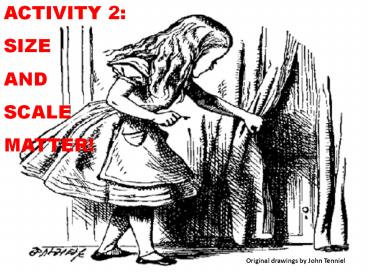ACTIVITY 2: - PowerPoint PPT Presentation
1 / 23
Title: ACTIVITY 2:
1
ACTIVITY 2 SIZE AND SCALE MATTER!
Original drawings by John Tenniel
2
(No Transcript)
3
http//www.ca.gov/
4
Terrestrial environment Soil Crumb
Photo and Diagram from Brock Biology of
Microorganisms, Madigan and Martinko
5
Aquatic EnvironmentMarine snow
Hot spots of bacterial concentration and
activity, contributing to global cycling of
carbon and nutrients
Azam and Long, Nature, 2001
6
Sampling soil microbes in a relatively static
soil community
7
(No Transcript)
8
- Examples of microbial communities requiring
different sampling considerations - Small, isolated (non-interacting), moderate
density, highly diverse (Drop-soda lakes,
hypersaline mats) - Small, isolated but interacting, high density,
moderately diverse (Gut, Ley) - Small, isolated but interacting, low density,
moderately diverse (Finlay and Fenchel) - Large, continuous, highly diverse????? What do
you suggest?
9
Drop-size soda lakes (Qvit-Raz , Genetics,
2008) This is an amzing study showing actual
differences in complex communities that go
through successional stages in tiny drops that
form from dew and exudates of the Tamarax tree
which releases salty compounds.
Back to list
10
GUT MICROBIAL COMMUNITY
Ley et al., 2006
Back to list
11
BIOGEOGRAPHY IS EVERYTHING EVERYWHERE???
Fenchel and Finlays work, as reported in
Science, 2005
Back to list
12
PNAS, 2007
13
ACTIVITY 2 Lets sample some diagrammatic
representations of microbial communities!
14
(No Transcript)
15
BRAINSTORM HOW DOES ONE MAKE DECISIONS ABOUT
SAMPLING?
- Size of population, community or system, area of
interest - Scope of study?
- Budget?
- Variability (standard deviation, error)? depends
on heterogeneity, abundance, distribution, both
spatial and temporal, method, etc. - Technological ability (Can one directly observe
organisms or cells? Can one target individuals or
groups with specificity? How precise are the
units of measurement?) - Experimental approach
- SCALE! (many issues)
STATISTICAL METHODS AND PRIMER, ENVIRONMENTAL
APPLICATIONS http//epa.gov/bioindicators/statpri
mer/
16
- EXAMINE YOUR BACTERIAL COMMUNITY and answer
the following questions - Would it be more appropriate to sample a large
number of small plots, or fewer large plots?
Considering the scale, how many large plots would
be feasible to measure? Would sampling a larger
number of smaller plots be less or more costly or
time consuming? - Would using a line transect approach be
appropriate? What would be the advantages or
disadvantages to using this method, compared to
plot sampling? - Describe a microbial ecosystem or community that
you feel most closely matches the hypothetical
community that your diagram represents.
17
B
A
C
D
18
D
C
19
SOME SAMPLE DATA
Site C Small plot Small plot Large plot
count count count Transects
Species 1 2 3 4 5 6 7 8 9 1 1 2 3
A 0 0 0 3 0 0 1 0 0 0 0 0 0
B 0 0 0 5 0 0 0 0 0 0 0 0 0
C 0 0 0 1 0 0 0 0 0 0 0 0 0
D 0 0 0 1 0 0 0 0 0 0 0 0 0
E 8 0 0 0
F 18 0 0 0
G 2 0 0 0
H 1 0 0 0
Site D Small plot Small plot Large plot
count count count Transects
Species 1 2 3 4 5 6 7 8 9 1 1 2 3
A 8 0 0 0 0 0 1 0 0 6 1 1 0
B 3 2 1 0 0 0 1 0 2 5 2 1 0
C 2 2 1 1 1 0 2 0 0 4 0 0 0
D 1 3 0 0 0 0 1 0 0 1 0 1 0
E 1 4 0 0 0 0 0 1 0 1 0 0 0
F 1 16 0 1 0 0 0 0 5 12 1 0 0
G 2 1 6 0 0 0 0 1 0 4 3 0 1
H 0 1 4 0 2 0 4 0 0 1 2 0 2
I 0 0 5 0 0 2 0 0 0 1 5 1 1
J 0 0 0 0 0 1 0 0 0 0 0 1 0
K 0 0 0 0 0 2 0 0 0 7 0 2 0
L 0 0 5 0 14 0 0 0 0 8 1 0 2
M 0 0 3 11 10 0 0 0 1 3 0 0 3
20
Findlay 1982 Both approaches yield similar
estimates of abundance, but larger scale sampling
tends to give poor representationof
distribution/patchiness
21
WHAT ABOUT MICROBIAL COMMUNITIES? Ranjard et al.
2003 tested effect of SIZE of soil sample used in
molecular community analysis. For bacteria,
SIZE OF SAMPLE did not affect ability to
distinguish unique communities from one another.
For fungi, samples lt1g may not be
adequate. HOWEVER, in larger samples, technique
of DNA extraction is biased toward dominant
organisms and may not accurately assess
diversity. FOR BACTERIA Many subsamples are
often taken, and it is the selection of the
sampling location that will give best indicator
of larger scale abundance and diversity
22
- When is use of transect appropriate?
- One example when one hypothesizes a gradient
relationship and wishes to test it using
regression analysis, see below! - In this study, researchers looked for change in
numbers of fecal indicator organisms across
various transects in relation to waters edge. - Keep in mind, most aquatic depth sampling is, in
effect transect sampling
Desmarais 2002
23
- FINAL THOUGHTS
- The question being asked drives the experimental
design. - The practical limitations of sampling limit the
type of question that can be asked and
answered! - Pilot sampling is always essential to assess the
nature of the system!!































